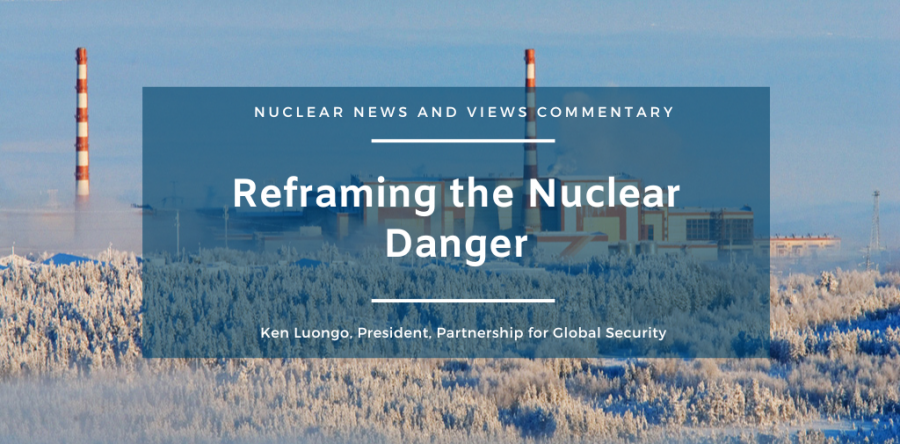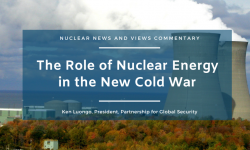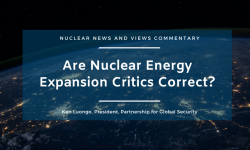The advent of nuclear weapons in 1945, documented in the new movie Oppenheimer, launched a bonanza of radioactivity-driven fear movies and monsters, featuring Godzilla, tarantulas, ants, and assorted zombies.
These cultural contributions, along with the demonstrated dreadful results of atomic weapons use and above-ground testing, developed into a dominant framework for assessing nuclear technology – that it was a reckless danger that needed to be controlled.
But that framing requires rethinking as global challenges and needs have evolved.
In the seven-plus decades since the Trinity test, new and acute concerns have arisen for which peaceful nuclear technology may offer an answer rather than a risk. There clearly is an important role for nuclear energy in addressing the extremely difficult challenge of global decarbonization.
Reframing the nuclear issue in response to modern challenges would move it closer to the original mission of the International Atomic Energy Agency. That is, to support the value of nuclear technology in addressing global problems while ensuring robust barriers to its use in weapons and high levels of nuclear security.
This rethinking would elevate the nuclear opportunity that has been obscured under the mushroom cloud of the bomb while maintaining the commitment to the global guardrails required to prevent nuclear proliferation and arms races.
The balancing of good and bad nuclear attributes largely has been lost within the nuclear security policy community in developed countries. Instead, the focus has primarily been on the nuclear danger and how nuclear power may abet that.
The agenda of limiting nuclear weapons and materials, preventing proliferation, and eliminating the opportunities for nuclear terrorism is vitally important and needs to continue and be strengthened.
But it is now abundantly clear that the fundamental foundations of this regime are being deteriorated at a rapid pace by changes in geopolitics, weapons technologies, and competing existential threats.
There is a desperate need to reboot this system to make it work in modern circumstances. The need for novel approaches and creative solutions is clear. But the intense focus on nuclear dangers without balancing the value of energy in the nuclear security policy community is one reason why the recruitment of new experts is failing and the field is in decline.
One of the key issues to evaluate is how to disentangle the opportunity offered by nuclear energy from its potential contribution to weapons.
Surprisingly, the Russian invasion of Ukraine has in a way begun to separate and clarify the nuclear opportunity and nuclear danger issues.
The war has heightened fears about Russia’s nuclear weapons saber rattling, the potential use of nuclear weapons on the battlefield, and the overall diminishment of the global nuclear security environment.
The most recent Nuclear Security Index from the Nuclear Threat Initiative, states that the level of global nuclear security is “regressing” in part because major nuclear nations like Russia have flouted global nuclear norms.
But Russia’s actions, including violating international guidelines at the Zaporizhzhia Nuclear Power Plant, also have exposed the importance of nuclear power for Ukraine’s security and economy.
This is a message being absorbed by other countries including in the developing economy world. They are struggling with economic and population growth, energy shortages, and the need to cleanly power their progress.
Last year, at an IAEA event on the role in nuclear power in Africa, Ghana’s Minister of Environment, Science, Technology, and Innovation, stated, “Ghana is looking to introduce nuclear power to provide the necessary diversity of baseload to ensure energy security for our future demands.”
This statement was made while noting that Ghana’s, “hydropower potential is almost exhausted.” Hydropower accounts for 40% of Ghana’s power and in several other African nations hydropower exceeds 80% of generation. Climate change is negatively impacting the water supply for this carbon free energy.
Russia and China very clearly see the opportunity in Africa.
China’s Belt and Road Initiative is active in virtually every African country and has invested $155 billion in projects in Sub-Saharan nations.
Russia is hosting its second Russia-Africa Summit this week. In his statement to the attendees, Vladimir Putin noted that Russian trade with Africa increased in 2022 to almost $18 billion. And that, “Russian companies are interested in working more actively on the continent in the sphere of high technologies…including nuclear power.”
It also is important to note that BRICS countries (Brazil, Russia, India, China, and South Africa) have already reached equal GDP purchasing power with the G-7 countries and are projected to exceed those developed nations this decade. Further, BRICS countries represent 43% of the global population, while the G-7 is about 10%. These, and other developing economy countries, also are increasingly resisting the western dominated international system.
These trends could spell trouble for international security and stability if the continued dominance of the current nuclear danger mantra makes it harder for developing nations to gain access to the secure, clean energy they need for their growing populations and economies.
These circumstances argue for serious thinking about a fresh framework for nuclear technology that would support both energy and global security objectives. A reframing of the current nuclear danger narrative could support the modern challenges of global economic growth, zero-carbon energy and security, and result in more effective designs for managing nuclear downsides.
| Ken Luongo, President, Partnership for Global Security |





